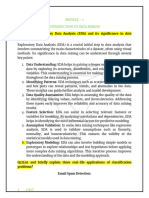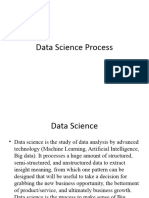0 ratings0% found this document useful (0 votes)
15 viewsExploratory Data Analysis Using Python
Exploratory Data Analysis (EDA) involves analyzing and visualizing data to gain insights and identify relationships between variables. Key steps include calculating summary statistics, identifying missing values, visualizing data using plots and graphs, transforming variables if needed, and examining correlations between variables.
Uploaded by
bbboss2266Copyright
© © All Rights Reserved
Available Formats
Download as PDF, TXT or read online on Scribd
0 ratings0% found this document useful (0 votes)
15 viewsExploratory Data Analysis Using Python
Exploratory Data Analysis (EDA) involves analyzing and visualizing data to gain insights and identify relationships between variables. Key steps include calculating summary statistics, identifying missing values, visualizing data using plots and graphs, transforming variables if needed, and examining correlations between variables.
Uploaded by
bbboss2266Copyright
© © All Rights Reserved
Available Formats
Download as PDF, TXT or read online on Scribd
You are on page 1/ 7
Exploratory Data Analysis (Python)
Exploratory Data Analysis (EDA) is a crucial step in any
data analysis project. It involves analyzing and visualizing
data to gain insights, understand patterns, and identify
potential relationships between variables.
Tools used: Python, R, Excel, Apache Spark
Summary Statistics: Calculate basic statistics such as
mean, median, mode, standard deviation, range, etc., to
summarize the dataset's main characteristics.
• Information about the data
• Checking Data types only
• Summary Statistics of numerical data
• Summary Statistics of categorical data
Missing Values: Identify missing values in the dataset
and decide on appropriate strategies for handling them,
such as imputation or deletion.
Data Visualization: Use various graphs and plots to
visualize the data, including histograms, box plots,
scatter plots, bar plots, etc. Visualization helps in
understanding the distribution of variables, identifying
outliers, and spotting trends or patterns.
Data Transformation: Perform transformations on
variables if needed, such as log transformations,
normalization, or standardization, to make the data more
suitable for analysis or modeling.
Correlation Analysis: Examine the relationships between
variables using correlation coefficients or correlation
matrices. This helps in understanding the strength and
direction of relationships between variables.
You might also like
- Data Analyst Interview Question and AnswerNo ratings yetData Analyst Interview Question and Answer51 pages
- What Is Exploratory Data Analysis (EDA) ?No ratings yetWhat Is Exploratory Data Analysis (EDA) ?6 pages
- 22amh32 - Data Analytics and Data Science Unit I & Exploratory Data Analysis (Eda) 1. Exploratory Data Analysis (Eda)No ratings yet22amh32 - Data Analytics and Data Science Unit I & Exploratory Data Analysis (Eda) 1. Exploratory Data Analysis (Eda)9 pages
- Why Exploratory Data Analysis is ImportantNo ratings yetWhy Exploratory Data Analysis is Important2 pages
- Explanatory Data Analysis (EDA) - CompleteNo ratings yetExplanatory Data Analysis (EDA) - Complete4 pages
- Top 50 Data Analyst Interview QuestionsNo ratings yetTop 50 Data Analyst Interview Questions51 pages
- Week 2. Data Presentation, Analysis and Discussions_015512No ratings yetWeek 2. Data Presentation, Analysis and Discussions_0155129 pages
- Antim-Prahar-Data-Analytics-for-Business-Decisions-2025_compressedNo ratings yetAntim-Prahar-Data-Analytics-for-Business-Decisions-2025_compressed44 pages
- Illuminating Data: A hands on guide to data visualization in RFrom EverandIlluminating Data: A hands on guide to data visualization in REman AhmadNo ratings yet
- 22amh32 - Data Analytics and Data Science Unit I & Exploratory Data Analysis (Eda) 1. Exploratory Data Analysis (Eda)22amh32 - Data Analytics and Data Science Unit I & Exploratory Data Analysis (Eda) 1. Exploratory Data Analysis (Eda)
- Week 2. Data Presentation, Analysis and Discussions_015512Week 2. Data Presentation, Analysis and Discussions_015512
- Antim-Prahar-Data-Analytics-for-Business-Decisions-2025_compressedAntim-Prahar-Data-Analytics-for-Business-Decisions-2025_compressed
- Illuminating Data: A hands on guide to data visualization in RFrom EverandIlluminating Data: A hands on guide to data visualization in R
































































